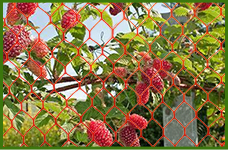Durable Plastic Protective Netting for Enhanced Safety and Versatility in Various Applications
10 月 . 18, 2024 12:43
The Versatile Applications of Plastic Protective Netting
In a world increasingly focused on safety, sustainability, and efficiency, plastic protective netting has emerged as a versatile solution across various industries. From agriculture to construction, this innovative material offers a wide range of benefits, protecting both products and people while promoting more sustainable practices.
Understanding Plastic Protective Netting
Plastic protective netting is made from durable materials like polyethylene or polypropylene, known for their lightweight yet robust characteristics. Available in various mesh sizes and colors, this netting is designed to serve multiple purposes, from safeguarding crops and animals to ensuring safety at construction sites. Its primary function is to provide a physical barrier that prevents damage or injury, making it an invaluable asset in today’s fast-paced world.
Applications in Agriculture
One of the most significant uses of plastic protective netting is in agriculture. Farmers employ this netting to protect crops from pests, birds, and harsh weather conditions. By covering fields with netting, growers can minimize damage caused by insects and birds, leading to more bountiful harvests. Additionally, netting can shield young plants from heavy rains or strong winds, reducing the likelihood of uprooting or breakage. In regions prone to hail storms, special hail netting can prevent crop loss, giving farmers a more reliable yield.
Not only does this protective measure enhance productivity, but it also promotes sustainable practices. By reducing the need for pesticides to combat pests, farmers can contribute to healthier ecosystems and align with the growing demand for organic produce. Plastic netting thus plays a crucial role in both protecting crops and promoting environmentally friendly agricultural practices.
Safety in Construction
plastic protective netting

In the construction industry, plastic protective netting serves as an essential safety feature. It is commonly used to prevent debris from falling off structures, safeguarding workers and the public below. Whether on scaffolding or temporary barriers, this netting effectively contains materials, reducing the risk of accidents. Moreover, it can be utilized to secure construction sites, restricting access to unauthorized individuals and ensuring safety protocols are met.
The lightweight nature of plastic netting also allows for easy installation and removal, making it a practical choice for contractors who need to adapt to various project requirements. This adaptability is further complemented by the durability of the materials, which withstand harsh weather conditions without compromising safety.
Environmental Considerations
As industries strive towards sustainability, the use of plastic protective netting also raises important discussions about environmental impact. While plastic products are often criticized for their contribution to pollution, advancements in manufacturing processes have led to the creation of recyclable and biodegradable netting options. These innovations allow for the responsible use of plastic, enabling netting to serve its protective purpose without contributing heavily to waste.
Moreover, by minimizing crop damage in agriculture and enhancing safety in construction, plastic protective netting indirectly supports a more sustainable economy. Fewer resources are wasted on product loss, and fewer accidents lead to less disruption of projects and ultimately a more efficient use of materials.
Conclusion
The versatility of plastic protective netting cannot be overstated. Its applications in agriculture and construction illustrate its importance in enhancing safety, maximizing productivity, and supporting sustainable practices. As industries continue to evolve, the adoption of plastic protective netting will likely grow, offering innovative solutions to modern-day challenges. By recognizing its benefits, businesses can make informed choices that not only protect their assets but also contribute positively to the environment and society as a whole. Thus, plastic protective netting stands out as a prime example of how practical solutions can align with the broader goals of safety and sustainability.




















